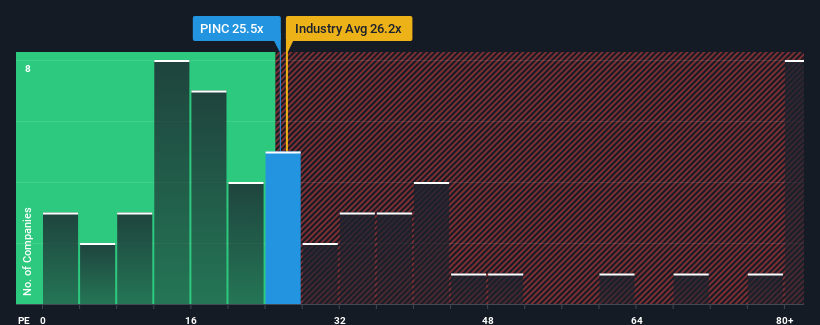- United States
- /
- Healthcare Services
- /
- NasdaqGS:PINC
Premier, Inc. (NASDAQ:PINC) Not Lagging Market On Growth Or Pricing

When close to half the companies in the United States have price-to-earnings ratios (or "P/E's") below 17x, you may consider Premier, Inc. (NASDAQ:PINC) as a stock to potentially avoid with its 25.5x P/E ratio. Nonetheless, we'd need to dig a little deeper to determine if there is a rational basis for the elevated P/E.
Recent times haven't been advantageous for Premier as its earnings have been falling quicker than most other companies. One possibility is that the P/E is high because investors think the company will turn things around completely and accelerate past most others in the market. If not, then existing shareholders may be very nervous about the viability of the share price.
See our latest analysis for Premier

How Is Premier's Growth Trending?
The only time you'd be truly comfortable seeing a P/E as high as Premier's is when the company's growth is on track to outshine the market.
If we review the last year of earnings, dishearteningly the company's profits fell to the tune of 56%. This means it has also seen a slide in earnings over the longer-term as EPS is down 58% in total over the last three years. Therefore, it's fair to say the earnings growth recently has been undesirable for the company.
Looking ahead now, EPS is anticipated to climb by 42% each year during the coming three years according to the eight analysts following the company. That's shaping up to be materially higher than the 10% per year growth forecast for the broader market.
With this information, we can see why Premier is trading at such a high P/E compared to the market. It seems most investors are expecting this strong future growth and are willing to pay more for the stock.
The Key Takeaway
We'd say the price-to-earnings ratio's power isn't primarily as a valuation instrument but rather to gauge current investor sentiment and future expectations.
As we suspected, our examination of Premier's analyst forecasts revealed that its superior earnings outlook is contributing to its high P/E. At this stage investors feel the potential for a deterioration in earnings isn't great enough to justify a lower P/E ratio. It's hard to see the share price falling strongly in the near future under these circumstances.
Before you take the next step, you should know about the 3 warning signs for Premier that we have uncovered.
Of course, you might also be able to find a better stock than Premier. So you may wish to see this free collection of other companies that have reasonable P/E ratios and have grown earnings strongly.
New: Manage All Your Stock Portfolios in One Place
We've created the ultimate portfolio companion for stock investors, and it's free.
• Connect an unlimited number of Portfolios and see your total in one currency
• Be alerted to new Warning Signs or Risks via email or mobile
• Track the Fair Value of your stocks
Have feedback on this article? Concerned about the content? Get in touch with us directly. Alternatively, email editorial-team (at) simplywallst.com.
This article by Simply Wall St is general in nature. We provide commentary based on historical data and analyst forecasts only using an unbiased methodology and our articles are not intended to be financial advice. It does not constitute a recommendation to buy or sell any stock, and does not take account of your objectives, or your financial situation. We aim to bring you long-term focused analysis driven by fundamental data. Note that our analysis may not factor in the latest price-sensitive company announcements or qualitative material. Simply Wall St has no position in any stocks mentioned.
Have feedback on this article? Concerned about the content? Get in touch with us directly. Alternatively, email editorial-team@simplywallst.com
About NasdaqGS:PINC
Premier
Operates as a healthcare improvement company in the United States.
Adequate balance sheet and fair value.
Similar Companies
Market Insights
Community Narratives




